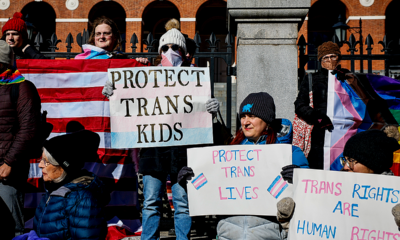Massachusetts
Lithium-ion battery fires jump rapidly in Massachusetts: ‘They’re nearly impossible to extinguish’

Firefighters across Massachusetts are facing the “nearly impossible” task of extinguishing lithium-ion battery fires much more often, according to new state data showing that such blazes have spiked sharply in the past half-year.
The state Department of Fire Service created a checklist last October for local departments to use to track the number of fires caused by lithium-ion batteries, which power large devices like electric vehicles and smaller items like smartphones and e-cigarettes.
So far, the form has helped 38 cities and towns identify 50 lithium-ion battery fires in the past six months, more than double the annual average detected by a national fire data reporting system, State Fire Marshal Jon M. Davine said in a release Wednesday.
The Massachusetts Fire Incident Reporting System, a state-level tool that mirrors and feeds into a national reporting system, recorded an average of 19.4 lithium-ion battery fires per year from 2019 to 2023.
“The increase since last fall could be due to the growing number of consumer devices powered by these batteries, increased attention by local fire investigators, or other factors,” Davine said.
The State Police Fire & Explosion Investigation Unit immediately started using the form which is optional for local fire departments to gather information when responding to fires involving lithium-ion batteries – make and model of the device, purchase history, and whether it was charging at the time of the blaze.
Brockton Deputy Chief Kevin Galligan told the Herald that he believes the number of lithium-ion battery fires since October is more than double the figure the DFS has reported. Firefighters are still being educated about the form and about the kind of fire, he said.
In the past, firefighters blamed the device for the fire and not the battery, Galligan said.
“I’m personally to a point where almost every fire I go to now I’m assuming I’ll be dealing with lithium-ion batteries,” he said, “whether they’re the cause of the fire or they were involved in the fire. It’s almost as if we can’t get away from them at this point.”
Nine of the 50 fires that DFS reported involved battery-powered scooters, e-bikes, and hoverboards. Eight involved laptops and another eight involved cell phones, tablets, or similar devices. Power tools were involved in six fires.
“The device’s charging status could be determined in 41 of the 50 fires: surprisingly, 56% of these devices were not charging at the time of the incident,” according to officials.
Lithium-ion battery fires are “much more intense” than a fire caused by careless disposal of a cigarette or cooking, Galligan said. Smaller devices that use lithium-ion batteries like a drill or a laptop are relatively easy to extinguish, but it’s a different story for larger items like vehicles, he said.
“They’re nearly impossible to extinguish and you use thousands of gallons of water trying to cool the batteries to prevent it spreading from battery to battery,” Galligan said. “Once a battery is in thermal runaway, there’s nearly nothing you could do to stop that single cell. … The only thing we could do is try to cool the batteries around it to stop the spread.”
Even after the fire is extinguished, there is still more work for firefighters as they have to make sure all batteries are removed from the scene so they don’t cause a rekindle, Galligan said.
New York City has made national headlines, with the number of incidents there, soaring well over 200, injuring more than 100 people and killing 14. After a series of fires involving faulty e-bike batteries including a blaze that claimed four lives last June, officials announced they were receiving a $25 million emergency grant from the federal government to fund scores of charging stations citywide.
“It’s a significant challenge for the fire service,” Galligan said. “We are constantly coming up against whatever the next problem is, and it does require a lot of training and additional equipment to address this. But it’s something that we have to face because the lithium-ion batteries are not going away.”

Massachusetts
Deadline nears for Massachusetts Health Connector enrollment

SPRINGFIELD — With just days left before the Dec. 23 deadline, state and local leaders are urging uninsured residents to enroll in health coverage through the Massachusetts Health Connector to ensure they’re protected in the new year. The cutoff applies to anyone who wants coverage starting Jan. 1.
The Health Connector — the state’s official health insurance marketplace — is the only place residents can access financial assistance and avoid misleading “junk” policies that often appear in online searches, according to a statement from the agency.
Officials say the enrollment period is especially critical for people without job-based insurance, gig workers, newcomers to the state and anyone seeking affordable, comprehensive health plans.
At a press conference Wednesday at Caring Health Center’s Tania M. Barber Learning Institute in Springfield, health leaders emphasized that most people who sign up through the Connector qualify for help paying premiums through its ConnectorCare program.
Audrey Morse Gasteier, executive director of the Massachusetts Health Connector, said the state has spent nearly two decades committed to ensuring access to health care and offering the most affordable coverage possible for everyone.
”And despite the federal challenges, we continue to do everything we can to offer coverage to everyone who needs it. Now is the time for people who don’t have coverage to come in, apply, and find out what kind of plan for which they qualify,” she said.
Open enrollment also gives current members a chance to review their coverage, compare options and make changes.
Recent changes in federal policy have caused shifts in coverage and higher premiums for many Massachusetts residents, creating uncertainty and concern, said Cristina Huebner Torres, chief executive vice president and strategy and research officer at Caring Health Center.
“During times like these, trusted, local support becomes even more essential, and our Navigators have been on the very front lines, helping residents understand their options, maintain coverage, and navigate a complex and evolving system,” Huebner Torres said.
Massachusetts
Massachusetts woman charged with DUI after Simsbury crash

SIMSBURY, Conn. (WTNH) — A Massachusetts woman was arrested Wednesday and charged with DUI after a crash in Simsbury, according to police.
The crash happened at around 2:15 p.m. on Hartford Avenue and Elm Street. Police responded to reports that one of the operators of the vehicles was unconscious, later becoming conscious.
Upon arrival, police found that operator, who was identified as 39-year-old Allison Beu of Southwick, Massachusetts, outside of her vehicle and interacting with the other involved parties.
The two occupants in the other vehicle were not transported to the hospital.
Beu was charged with DUI and failure to drive in proper lane.
Massachusetts
Massachusetts Governor Healey reacts to Brown University shooting

BOSTON (WWLP) – Following the shooting at Brown University, claiming the lives of two students and injuring nine others, Governor Healey is joining calls for anyone with information to contact authorities.
Police have not yet made any arrests in connection with the shooting, but they have released footage of a person of interest, calling on the public for help.
“At this time, we just have to encourage anyone in the public who may know something, see something, to immediately contact law enforcement,” said Healey.
Governor Healey says the Massachusetts State Police are in Rhode Island to assist with the investigation. The governor also spoke to mounting fear on college campuses, as the number of mass shootings in the United States exceeds the number of days so far in the year.
“In speaking with many of them, I know that they are taking all measures to ensure the safety of students and faculty, and certainly as a state we will do everything that we can to support those efforts,” said Governor Healey.
Local to western Massachusetts, UMass Amherst told 22News about their campus safety plans, which include adding emergency preparedness to student orientation and hosting optional active threat training for students, staff, and faculty.
The FBI is offering an award of up to $50,000 leading to an arrest and conviction. Anyone who thinks they may have information is encouraged to call the Providence Police.
Local News Headlines
WWLP-22News, an NBC affiliate, began broadcasting in March 1953 to provide local news, network, syndicated, and local programming to western Massachusetts. Download the 22News Plus app on your TV to watch live-streaming newscasts and video on demand.
-

 Iowa4 days ago
Iowa4 days agoAddy Brown motivated to step up in Audi Crooks’ absence vs. UNI
-

 Washington1 week ago
Washington1 week agoLIVE UPDATES: Mudslide, road closures across Western Washington
-

 Iowa6 days ago
Iowa6 days agoHow much snow did Iowa get? See Iowa’s latest snowfall totals
-

 Maine3 days ago
Maine3 days agoElementary-aged student killed in school bus crash in southern Maine
-

 Maryland4 days ago
Maryland4 days agoFrigid temperatures to start the week in Maryland
-

 Technology1 week ago
Technology1 week agoThe Game Awards are losing their luster
-

 South Dakota5 days ago
South Dakota5 days agoNature: Snow in South Dakota
-

 Nebraska1 week ago
Nebraska1 week agoNebraska lands commitment from DL Jayden Travers adding to early Top 5 recruiting class

























